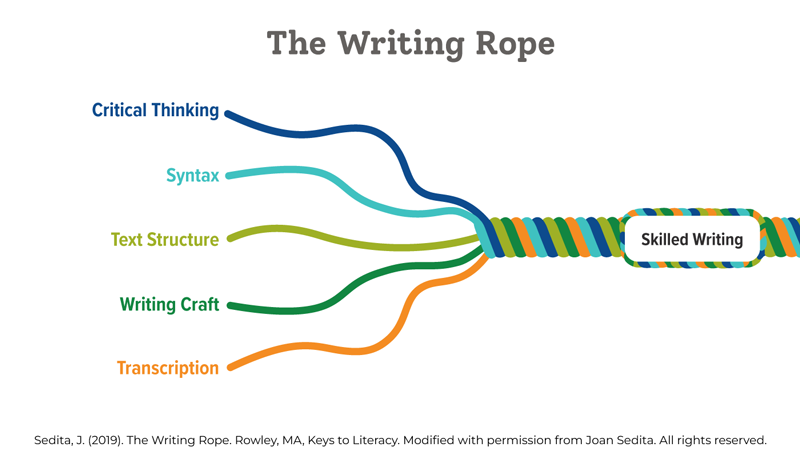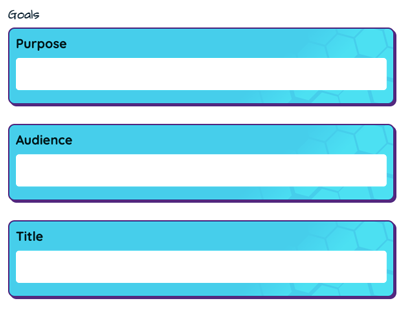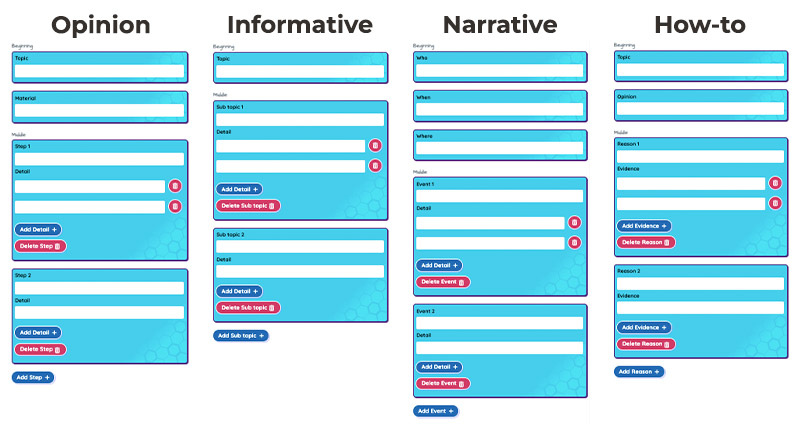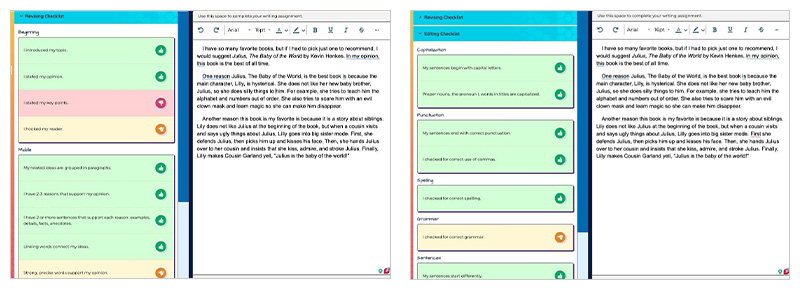Learning A-Z is excited to partner with Joan Sedita, founder of Keys to Literacy and author of The Writing Rope: A Framework for Explicit Writing Instruction in All Subjects, to help educators use the latest research to support all their students in becoming skilled writers. Using the model of The Writing Rope, let’s take a deep dive into the Critical Thinking strand to examine each stage of the writing process: think, plan, write, and revise. We’ll cover practical tools and strategies for educators to implement in their classrooms and show how The Writing Rope aligns with Writing A-Z®.
Weaving the Strands of The Writing Rope Together
One of the key aspects of The Writing Rope is that the strands are meant to be woven together rather than taught in isolation. Writing A-Z accomplishes this by building resources on teaching the writing process (Critical Thinking strand) within writing genre units: Opinion, Informative, and Narrative (Text Structure strand). By doing so, Writing A-Z teaches students to use each step of the writing process and to think critically as they write.

How Writing A-Z Aligns to The Writing Rope
See how the resources in our research-based writing solution, Writing A-Z, align to each strand of The Writing Rope to help teachers foster skilled writing for all K-5 students.
EXPLORE THE ROPESedita points out that students can not be expected to pick up a pencil and start writing. Writing requires critical thinking and begins when students think about their topic or task, gather information, and begin to record important ideas. Writing A-Z includes pre-writing lessons on brainstorming ideas, gathering evidence and information, and outlining notes in a writer’s notebook. Pre-writing activities flow into planning when students are ready to identify their writing task, audience, and purpose. Sedita refers to this as T.A.P and makes a connection to the Writing Craft strand, “Proficient writers should be thinking about these things as they are writing because they will influence many of the decisions they make during the writing process.” This is a perfect example of how the strands are woven throughout the writing process.
In Writing A-Z, students record their purpose and audience in the goals section of the graphic organizer (Writing Craft strand). This section is tied to the writing task found in the lesson plans and reminds students of their audience and purpose as they make decisions throughout the writing process.

Graphic Organizers in the Planning and Writing Stages of the Writing Process
Planning begins when students have identified their task, audience, and purpose (Writing Craft strand). The planning stage is synonymous with the use of graphic organizers. Sedita’s favorite graphic organizer is the “top-down” web. Writing A-Z provides similar graphic organizers to help students organize information and understand the genre structure they are writing (Text Structure strand). Let’s take a closer look at the Writing A-Z graphic organizers.
First, our graphic organizers are designed to look like an outline. This helps structure students’ note-taking during the planning stage of the writing process and supports the structure of their writing when they begin their first draft. All graphic organizers include the same sections: Goals, Beginning, Middle, and End. We have already shown the Goals section of the graphic organizer. Let’s examine how the Beginning and Middle sections are differentiated to support the writing genre. Notice that the headers in each section are specific to each genre, which supports students’ understanding of their unique structure.

The Beginning section of the Opinion graphic organizer includes Topic and Opinion, while the middle section contains Reason and Evidence. The beginning section of the Informative graphic organizer includes Topic, while the middle section contains Sub topic and Details. The beginning section of the Narrative graphic organizer includes Who, When, Where, while the middle section contains Events and Details. The beginning section of the How-to graphic organizer includes Topic and Material, while the middle section contains Steps and Details.
Graphic organizers are essential for writing instruction, especially as students learn to work through the different stages of the writing process and build those key writing and critical thinking skills (Critical Thinking strand). They help students organize their ideas and information while supporting their first drafts. Writing A-Z makes this even easier for students in a couple of key ways. First, in WaLT, which stands for Writing and Learning Together and serves as the digital writing interface within Writing A-Z, the graphic organizer is next to the drafting space, so students can easily transfer ideas from their graphic organizer to their draft. Second, the sections of the graphic organizer support students’ understanding of text structure by helping them know when to start a new paragraph (Text Structure strand).

Checklists in the Revise and Edit Stage of the Writing Process
After students write their first draft, it is time to revise and edit. To make effective improvements, students must first evaluate their writing. Writing A-Z provides students with revising and editing checklists to help them evaluate their drafts (Critical Thinking strand).
Just like the graphic organizers they used in the previous stages of the writing process, the revising checklists are genre-specific and sectioned. Students are taught to self-evaluate and peer-evaluate their writing to set revision goals, thus providing them with a starting point to improve their writing. The editing checklists are also sectioned by category so that students learn to edit their draft for one skill at a time (Syntax strand).

Explicit, Systematic Instruction to Nurture Skilled, Independent Writers
Sedita emphasizes writing instruction must address all the components of The Writing Rope and that it should begin with the teacher modeling explicitly, which includes thinking aloud and providing ample for students to practice before they try to do it independently. Every Writing A-Z lesson includes explicit, systematic steps and follows the Gradual Release of Responsibility model: I do, we do, you do. The “I Do” section of each lesson includes extensive sample dialogue designed to make teachers’ thinking visible to students. The “We Do” section transitions students to collaborative practice, and the “You Do” section allows students to practice their writing independently.
To learn more about The Writing Rope and how Writing A-Z aligns with its strands, check out the recording of our live webinar from March 2024 featuring Joan Sedita.
Writing A-Z: A Flexible, Research-Based K-5 Writing Solution
Teaching writing is hard, but it doesn’t have to be. Writing A-Z is an award-winning instructional solution that addresses essential writing and grammar skills critical to literacy success. Learn more and start your free 14-day trial today.
Try It Now

